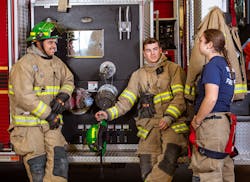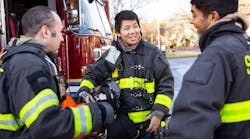The Flock Structure
This article is part of a larger supplement titled Recruiting and Retaining: The Future of Volunteer Fire Departments. View the supplement in its entirety here.
Recruitment and retention—R&R, Get ’em and Keep ’em or whatever you want to call it—is a hot topic in the fire service. Like any hot topic, you must decide how you can best utilize the “buzz” to improve your organization.
A quick review of your organization by using a “flock” analogy can be useful.
Goose versus seagull
The Canadian goose and the typical seagull are considered social-based birds, and they both interact within a flock structure. Volunteers, who make up 65 percent of America’s fire service, have a social component and tend to interact within groups, commonly referred to as departments.
Canadian geese fly in a V-type formation, which assists the group utilization of air currents, with many sharing the lead position to ensure that each leader receives a rest. On the ground, they share their field with different varieties of birds, calling to other geese that pass by to alert them to a “good field.” They also call to a single goose to bring it into the flock. While on the ground, the job of a lookout is shared. Although these are migratory birds, after finding a habitat that’s safe, has plentiful food and is of a like culture, some decide to permanently reside in one area.
On the other hand, the typical seagull is more solitary even though it gathers in a group. Gulls are very noisy, and their communication with other gulls tends to be more defensive and angrier, as opposed to friendly and welcoming. Gulls don’t readily share their food or feeding sites. Many people call them glutinous. Gulls stay around all year and generally are considered bothersome and messy.
Which one of these two bird cultures does your department resemble? As a leader, you must be willing to change the social climate to achieve the diversity and the inclusion that’s necessary for the volunteer fire service to survive. When people tend to quit, often it’s because they lost faith in their leaders or department.
Your department culture
What type of culture have you, as a leader, created for your department? Sometimes, people become so accustomed to old ways of thinking and of doing things that they don’t realize that they’re placing constraints on their department, members and program options. Does your department have an open-door policy that encourages a wide diversity of members? Does the picture that your department paints to the public reflect a trusting, open-minded environment? It doesn’t matter how noble or worthwhile your cause; if you haven’t earned people’s trust, they won’t join.
What reputation does your department portray? Does your department pay attention to the power of language? As a leader, you must understand that differences in speaking and listening styles can cause many misunderstandings and confusion. When we utilize jargon and “firehouse humor” with new and prospective members, you might find that they consider you a “gull.”
Maybe now is the time to make sure that you’re doing the right things and letting go of action items that aren’t going to accomplish your goals. No good can come from remaining silent when something is morally or ethically wrong. Others who have a conscience eventually will follow you. Those who don’t follow soon will fall by the wayside.
Leadership success depends upon identifying skill sets and capitalizing on them. An assessment and inventory of your department’s strengths will be the foundation. Identify goals and the action steps that you need to take to organize a successful R&R program. Eliminate obstacles to success, just like the geese who choose not to migrate.
As with any behavioral or cultural change, incremental progress tends to be the most effective. Don’t accept excuses from others or from yourself. Yes, procrastination is an excuse.
As long as your ideas stay in your head or just words in a manual or plan, they never will make a difference. For these ideas to start to evolve, you have to “give them wings,” so your flock can make them soar.
If you really want your department or program to become a “goose,” you will find a way. If you don’t, you will find an excuse and remain a “gull.”
About the Author
Ken Brown has a long career in the Virginia fire service, including serving as director of fire services for Prince George County, company officer with the City of Newport News Fire Department, fire chief for the 909th CES Fire Department USAFR (ret.), administrative battalion chief with the Carson Volunteer Fire Department and a lifetime member of Gloucester Volunteer Fire & Rescue. He serves as the Virginia director on the National Volunteer Fire Council (NVFC) and chair of the NVFC’s recruitment and retention committee. Brown is president of the Virginia State Firefighters Association and served 13 years on the Governors Fire Services.Ken Brown
Ken Brown has a long career in the Virginia fire service, including serving as director of fire services for Prince George County, company officer with the City of Newport News Fire Department, fire chief for the 909th CES Fire Department USAFR (ret.), administrative battalion chief with the Carson Volunteer Fire Department and a lifetime member of Gloucester Volunteer Fire & Rescue. He serves as the Virginia director on the National Volunteer Fire Council (NVFC) and chair of the NVFC’s recruitment and retention committee. Brown is president of the Virginia State Firefighters Association and served 13 years on the Governors Fire Services.










